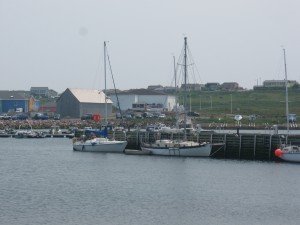
Summer, it seems, has arrived at last here in the middle north, and we got a beautiful weather window to leave Sydney just a few days after arriving. After spending a night tied up to the bulkhead at Dobson’s Yacht club in order to take on drinking water, to shower and launder and fill up on propane, we sailed off at dawn and had cleared the harbor before the kids woke up. It was a mostly quiet passage, with an easy wind dead astern and not enough swell to really annoy. Just after dark the wind fell calm and we doused the mainsail to prevent flogging, sheeted the headsails in tight and went to bed with a kitchen timer jolting us up every thirty minutes to take a look around.

The timer proved hardly necessary, since in the slight roll the leathered boom jaws grounched most horribly against the mast, and it was a relief when the lightest breeze sprang up at midnight and we could carry sail again. Twelve hours later it became evident that we could just fetch St. Pierre before dark by maintaining five knots, so we fired up the aluminum tops’l to help the scanty wind along a little. By sunset Ganymede was rounding the northern tip of St Pierre, it’s rugged crags aflame in the day’s last glow. Here again we felt the katabatic winds as the steep hills accelerated the breeze to shocking force and slowed Ganymede down to a crawl as she turned dead upwind to enter the harbor.

We hadn’t really meant to stop here when we left Sydney, but the idea of being anchored for the night is terribly alluring when you’re out at sea, and from all reports the coast of Newfoundland to the eastward has but scanty supplies and civilization. Since we had abandoned our plan to sail to St John, hearing nothing but negative things about it, St Pierre, we thought, would be as good a place as any to prepare for the next phase of our cruise.

This and Ile Miquelon just to the north, though only fourteen miles from Canada, are French territory, so our first duty was to clear customs, then figure out where to berth Ganymede, since the outer harbor we had anchored in was too exposed and remote for comfort. In what seems to be the normal procedure in these parts, we tied up to the yacht club quay, for lack of better ideas, and stayed there overnight before encountering anyone to ask permission of. When I spoke to them next day it seemed inconceivable to them that one would hesitate to tie up to any handy quay whether anyone was around or not.

It seemed that it would cost one Euro (no Canadian dollars here, if you please—this is France!) per foot per day. Depending on the exchange rate, that could be really good or really poor, but the exchange rate would have to wait until the bank opened next day. We spent a restful weekend in ignorance wandering around town and relaxing, unable to ascertain how expensive things were since all the businesses were closed. It’s a charming place, and feels lots more foreign than Canada, probably because I don’t speak a lick of French and can’t read any of the signs.

Antigone and Emily had been dying to jig for cod ever since I’d told them they could be caught with a silver spoon. Even learning that “spoon” was just a certain kind of lure, not that one tied a hook to a teaspoon didn’t dim their enthusiasm. Our scanty fishing tackle had several small spoon lures, and soon they were industriously jigging away at the end of the quay. I had expected as much to come of it as of their usual fishing efforts, and what a surprise to find a few hours later that eight fish—four cod and four conner were swimming about in our dishwashing tubs. They were all pretty small, but cleaned and cooked they must be, regardless of size.

After filleting most of them herself, Antigone realized why people throw the small ones back. Even with the help of a friendly Newfoundlander off the neighboring boat who showed us exactly how it’s done (“You always cut on the fish’s portside first, see.” “Why?” we asked. “Don’t know—we just always done it that way.”) it was a long and painful process. Still they made a few bites each, sauteed in butter. The Newfies next door must have thought we were truly hungry indeed, to be eating such poor fish, and gave us three Mason jars of preserved meat—full clams, clam pieces, and caribou. Evidently all great delicacies in Newfoundland, though not much to look at inside a glass jar.

At the bank on Monday our fulgent outlook was dimmed somewhat by finding that not only was the Euro prospering inordinately against the dollar, but that this calamity was exacerbated by a 12-dollar currency exchange fee. I didn’t discover this last brazen bit of thievery until it was too late, partly due to the language barrier, and partly because they applied it without the slightest compunction. In Canada the bank tellers had been careful to warn me, with decorous embarrassment, about a 3-dollar transaction fee. Not here; a fool and his money are soon parted, and perhaps we’re wiser now and will figure out a better way.

With that behind us we’ve spent the last several days, after moving off the yacht club wharf, getting ready for the big jump. The season to go is now—the weather won’t get any better, and there’s little to gain by cruising further east along Newfoundland. By the time this posts, we’ll be either well on our way across the Atlantic to Ireland, or have changed our minds and be cooking up Plan B. Give it three or so weeks, then look for a posting from wherever we wind up next.